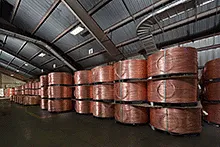(July 20, 2022) The supply of copper needs to almost double by 2035 to meet global carbon-reduction goals, and without substantial changes, the mining industry will be unable to fill that demand, according to a new report by S&P Global. The independent assessment also warns that efforts to attain net-zero greenhouse gas emissions by 2050 will fail unless that gap is closed.
According to the report, “The Future of Copper,” electrification is the key to meeting the carbon-reduction commitments outlined in the Paris Climate Agreement. Copper is a critical component of electrification because of its conductivity. Electric vehicles, advanced batteries, clean energy generation and enhanced power transmission infrastructure will drive the surge in demand for copper.
A webinar addressing findings in the report and the report itself can be accessed here. Access will require registering for the event, which can be completed at the bottom of the page.
To attain net-zero emissions by 2050, substantial moves toward electrification will need to happen in the next dozen years, according to the report. Demand for copper is projected to grow from about 25 million metric tons worldwide today to almost 50 million metric tons by 2035 before tapering off to about 53 million metric tons by 2050.
‘Massive new supply’ of copper needed
“This surge in demand to meet Net-Zero Emissions by 2050 requires a near doubling of today’s global copper supply by 2035, an expansion that current exploration trends or projects in the feasibility stage of development are incapable of meeting,” the S&P Global report concludes. “Unless massive new supply comes online in a timely way, the goal of Net-Zero Emissions by 2050 will be short-circuited and remain out of reach.”
The study from S&P Global was conducted to assess the future mismatch between copper supply and demand as the move to electrification drives the need for more of the metal. The study assesses how big the copper gap will be using two scenarios. One is based on continuing existing rates of recycling and use of mines and refineries. The other is more optimistic about future improvements in recycling and technology.
Both scenarios predict big shortfalls in the availability of copper beginning in 2025, as the large-scale transition away from fossil fuels ramps up. The current low price for copper is tied to short-term economic troubles, and should rebound after 2023 or 2024, said John Mothersole, Director, Economics and Country Risk at S&P Global, during a webinar announcing the findings. The copper deficit will spike sharply until about 2035 as people switch to electric cars and power companies transition to clean generating technologies. After that, the rapid transition to electric vehicles will largely be complete, and the demand for copper will hold steady through about 2050.
